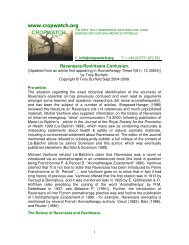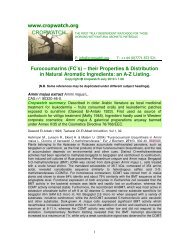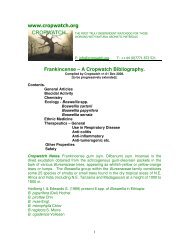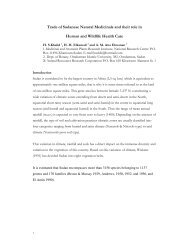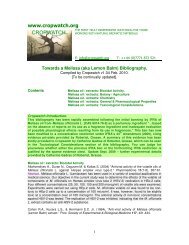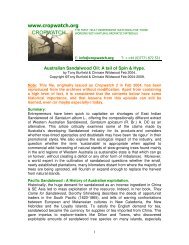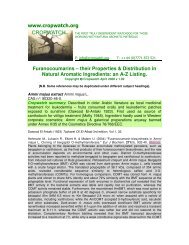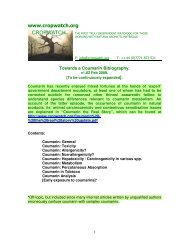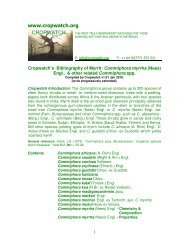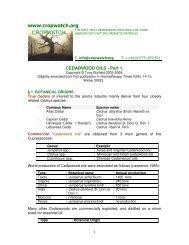Sandalwood Biblio - Cropwatch
Sandalwood Biblio - Cropwatch
Sandalwood Biblio - Cropwatch
You also want an ePaper? Increase the reach of your titles
YUMPU automatically turns print PDFs into web optimized ePapers that Google loves.
Banerjee S., Ecavade A. & Rao A.R. (1993) “Modulatory influence of sandalwood oil on mouse<br />
hepatic glutathione S-transferase activity and acid soluble sulpydryl level” Cancer Lett 68(2),<br />
105-9. Abstract: The effect of the oil from the wood of Santalum album on glutathione S-<br />
transferase (GST) activity and acid soluble sulphydryl (SH) levels in the liver of adult male Swiss<br />
albino mice was investigated. Oral feeding by gavage to mice each day with 5 and 15 microliters<br />
sandalwood oil for 10 and 20 days exhibited an increase in GST activity in time- and doseresponsive<br />
manners. Feeding a dose of 5 microliters sandalwood oil for 10 and 20 days caused,<br />
respectively, a 1.80-fold (P < 0.001) and 1.93-fold (P < 0.001) increase in GST enzyme activity,<br />
while feeding a dose of 15 microliters of the oil per day for 10 and 20 days induced, respectively,<br />
4.73-fold (P < 0.001) and 6.10-fold (P < 0.001) increases in the enzyme's activity. In addition,<br />
there were 1.59-fold (P < 0.001) and 1.57 (P < 0.001) increases in acid-soluble SH levels in the<br />
hepatic tissue of the mice following feeding of the oil at the dose levels of 5 and 15 microliters for<br />
10 days. Furthermore, mice fed on a diet containing 1% 2(3)-butyl-4-hydroxyanisole (positive<br />
control) also showed an increase in hepatic GST activity and SH levels. Enhancement of GST<br />
activity and acid-soluble SH levels are suggestive of a possible chemopreventive action of<br />
sandalwood oil on carcinogenesis through a blocking mechanism.<br />
Dwivedi C. & Abu-Ghazaleh A. (1997) "Chemopreventive effects of sandalwood oil on skin<br />
papillomas in mice." Eur J Cancer Prev. 6(4), 399-401. Abstract. The essential oil, emulsion or<br />
paste of sandalwood (Santalum album L) has been used in India as an ayurvedic medicinal agent<br />
for the treatment of inflammatory and eruptive skin diseases. In this investigation, the<br />
chemopreventive effects of sandalwood oil (5% in acetone, w/v) on 7,12-<br />
dimethylbenz(a)anthracene-(DMBA)-initiated and 12-O-tetradecanoyl phorbol-13-acetate(TPA)-<br />
promoted skin papillomas, and TPA-induced ornithine decarboxylase (ODC) activity in CD1 mice<br />
were studied. <strong>Sandalwood</strong> oil treatment significantly decreased papilloma incidence by 67%,<br />
multiplicity by 96%, and TPA-induced ODC activity by 70%. This oil could be an effective<br />
chemopreventive agent against skin cancer.<br />
Dwivedi C., Guan X., Harmsen W.L., Voss A.L., Goetz-Parten D.E., Koopman E.M., Johnson<br />
K.M., Valluri H.B. & Matthees D.P. (2003) " Chemopreventive effects of alpha-santalol on skin<br />
tumor development in CD-1 and SENCAR mice." Cancer Epidemiol Biomarkers Prev. 12(2), 151-<br />
6. Abstract. Studies from our laboratory have indicated skin cancer chemopreventive effectsof<br />
sandalwood oil in CD-1 mice. The purpose of this investigation was to study the skin cancer<br />
chemopreventive effects of alpha-santalol, a principal component of sandalwood oil in CD-1 and<br />
SENCAR mice. alpha-Santalol was isolated from sandalwood oil by distillation under vacuum and<br />
characterized by nuclear magnetic resonance and gas chromatography-mass spectrometry.<br />
Chemopreventive effects of alpha-santalol were determined during initiation and promotion phase<br />
in female CD-1 and SENCAR mice. Carcinogenesis was initiated with 7,12-<br />
dimethylbenz(a)anthracene and promoted with 12-O-tetradecanoylphorbol-13-acetate (TPA). The<br />
effects of alpha-santalol treatment on TPA-induced epidermal ornithine decarboxylase (ODC)<br />
activity and (3)H-thymidine incorporation in epidermal DNA of CD-1 and SENCAR mice were also<br />
investigated. alpha-Santalol treatment during promotion phase delayed the papilloma<br />
development by 2 weeks in both CD-1 and SENCAR strains of mice. alpha-Santalol treatment<br />
during promotion phase significantly (P < 0.05) decreased the papilloma incidence and multiplicity<br />
when compared with control and treatment during initiation phase during 20 weeks of promotion<br />
in both CD-1 and SENCAR strains of mice. alpha-Santalol treatment resulted in a significant (P <<br />
0.05) inhibition in TPA-induced ODC activity and incorporation of (3)H-thymidine in DNA in the<br />
epidermis of both strains of mice. alpha-Santalol significantly prevents papilloma development<br />
during promotion phase of 7,12-dimethylbenz(a)anthracene-TPA carcinogenesis protocol in both<br />
CD-1 and SENCAR mice, possibly by inhibiting TPA-induced ODC activity and DNA synthesis.<br />
alpha-Santalol could be an effective chemopreventive agent for skin cancer. Additional<br />
experimental and clinical studies are needed to investigate the chemopreventive effect of alphasantalol<br />
in skin cancer.<br />
Dwivedi C., Maydew E.R., Hora J.J., Ramaeker D.M. & Guan X. (2005) "Chemopreventive effects<br />
of various concentrations of alpha-santalol on skin cancer development in CD-1 mice." Eur J<br />
30





